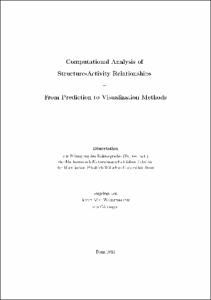Wassermann, Anne Mai: Computational Analysis of Structure-Activity Relationships : From Prediction to Visualization Methods. - Bonn, 2012. - Dissertation, Rheinische Friedrich-Wilhelms-Universität Bonn.
Online-Ausgabe in bonndoc: https://nbn-resolving.org/urn:nbn:de:hbz:5n-29085
Online-Ausgabe in bonndoc: https://nbn-resolving.org/urn:nbn:de:hbz:5n-29085
@phdthesis{handle:20.500.11811/5336,
urn: https://nbn-resolving.org/urn:nbn:de:hbz:5n-29085,
author = {{Anne Mai Wassermann}},
title = {Computational Analysis of Structure-Activity Relationships : From Prediction to Visualization Methods},
school = {Rheinische Friedrich-Wilhelms-Universität Bonn},
year = 2012,
month = jul,
note = {Understanding how structural modifications affect the biological activity of small molecules is one of the central themes in medicinal chemistry. By no means is structure-activity relationship (SAR) analysis a priori dependent on computational methods. However, as molecular data sets grow in size, we quickly approach our limits to access and compare structures and associated biological properties so that computational data processing and analysis often become essential.
Here, different types of approaches of varying complexity for the analysis of SAR information are presented, which can be applied in the context of screening and chemical optimization projects. The first part of this thesis is dedicated to machine-learning strategies that aim at de novo ligand prediction and the preferential detection of potent hits in virtual screening. High emphasis is put on benchmarking of different strategies and a thorough evaluation of their utility in practical applications. However, an often claimed disadvantage of these prediction methods is their "black box" character because they do not necessarily reveal which structural features are associated with biological activity. Therefore, these methods are complemented by more descriptive SAR analysis approaches showing a higher degree of interpretability. Concepts from information theory are adapted to identify activity-relevant structure-derived descriptors. Furthermore, compound data mining methods exploring prespecified properties of available bioactive compounds on a large scale are designed to systematically relate molecular transformations to activity changes.
Finally, these approaches are complemented by graphical methods that primarily help to access and visualize SAR data in congeneric series of compounds and allow the formulation of intuitive SAR rules applicable to the design of new compounds. The compendium of SAR analysis tools introduced in this thesis investigates SARs from different perspectives.},
url = {https://hdl.handle.net/20.500.11811/5336}
}
urn: https://nbn-resolving.org/urn:nbn:de:hbz:5n-29085,
author = {{Anne Mai Wassermann}},
title = {Computational Analysis of Structure-Activity Relationships : From Prediction to Visualization Methods},
school = {Rheinische Friedrich-Wilhelms-Universität Bonn},
year = 2012,
month = jul,
note = {Understanding how structural modifications affect the biological activity of small molecules is one of the central themes in medicinal chemistry. By no means is structure-activity relationship (SAR) analysis a priori dependent on computational methods. However, as molecular data sets grow in size, we quickly approach our limits to access and compare structures and associated biological properties so that computational data processing and analysis often become essential.
Here, different types of approaches of varying complexity for the analysis of SAR information are presented, which can be applied in the context of screening and chemical optimization projects. The first part of this thesis is dedicated to machine-learning strategies that aim at de novo ligand prediction and the preferential detection of potent hits in virtual screening. High emphasis is put on benchmarking of different strategies and a thorough evaluation of their utility in practical applications. However, an often claimed disadvantage of these prediction methods is their "black box" character because they do not necessarily reveal which structural features are associated with biological activity. Therefore, these methods are complemented by more descriptive SAR analysis approaches showing a higher degree of interpretability. Concepts from information theory are adapted to identify activity-relevant structure-derived descriptors. Furthermore, compound data mining methods exploring prespecified properties of available bioactive compounds on a large scale are designed to systematically relate molecular transformations to activity changes.
Finally, these approaches are complemented by graphical methods that primarily help to access and visualize SAR data in congeneric series of compounds and allow the formulation of intuitive SAR rules applicable to the design of new compounds. The compendium of SAR analysis tools introduced in this thesis investigates SARs from different perspectives.},
url = {https://hdl.handle.net/20.500.11811/5336}
}






